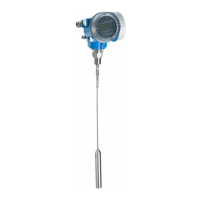Levelflex FMP56, FMP57
22 Endress+Hauser
0 5 10 15 20 25 30 35
0
5
10
15
20
25
30
pulling force, 6 mm rope [kN]
level [m]
silica sand
smooth metallic walls
silo diameter 12 m
silo diameter 9 m
silodiameter6m
silodiameter3m
0
2
4
6
8
10
12
14
16
18
20
pulling force, 4 mm rope [kN]
0 5 10 15 20 25 30 35
0
1
2
3
4
5
6
7
8
9
pulling force, 6 mm rope [kN]
level [m]
polyethylene pellets
smooth metallic walls
silo diameter 12 m
silo diameter 9 m
silodiameter6m
silodiameter3m
0
1
2
3
4
5
6
pulling force, 4 mm rope [kN]
0 5 10 15 20 25 30 35
0
2
4
6
8
10
12
14
16
18
pulling force, 6 mm rope [kN]
level [m]
wheat
smooth metallic walls
silo diameter 12 m
silo diameter 9 m
silodiameter6m
silodiameter3m
0
2
4
6
8
10
12
pulling force, 4 mm rope [kN]
0 5 10 15 20 25 30 35
0
5
10
15
20
25
30
pulling force, 6 mm rope [kN]
level [m]
cement
smooth metallic walls
silo diameter 12 m
silo diameter 9 m
silodiameter6m
silodiameter3m
0
2
4
6
8
10
12
14
16
18
20
pulling force, 4 mm rope [kN]
A0014133-EN
Since the tensile forces are also heavily dependent on the viscosity of the product, a higher safety factor is
necessary for highly viscous products and if there is a risk of cornice buildup. In critical cases it is better to use
a 6 mm rope instead of a 4 mm one.
The same forces also act on the silo cover. On a fixed rope, the tensile forces are definitely greater, but this can
not be calculated. Observe the tensile strength of the probes.
Options for reducing the tensile forces:
• Shorten the probe.
• If the maximum tensile load is exceeded, check whether it would be possible to use a non-contact Ultrasonic
or Level-Radar device.

